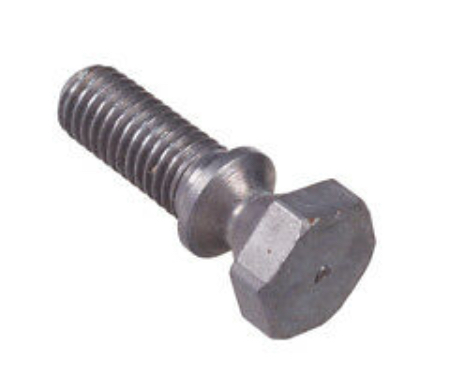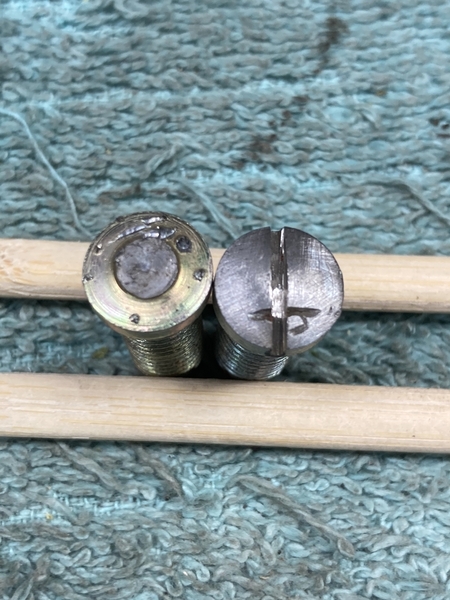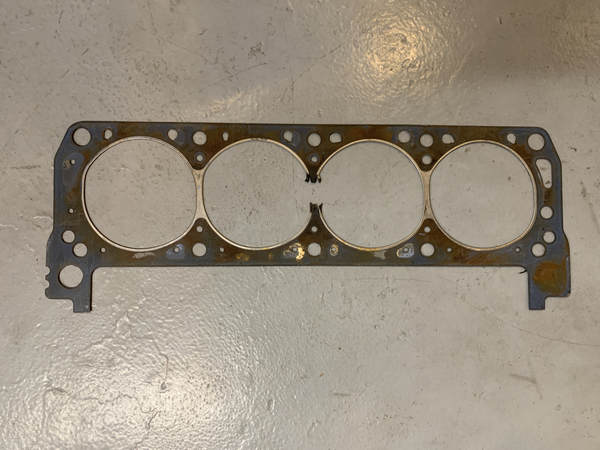Can use a little help here, i have a 73 pantera 32000 original miles but had a rebuild on the engine about 10 thousand miles ago to boss 351 specs solid pop up pistons and quenches heads solid lifter cam with lots of over lap and 606 lift cam,my question is to my understanding boss 351 compression was 11.1 on my rebuild spec states the compression is 11.7 just out of curiosity i ran a compression check every cylinder read 240 except 3 and 4 read 200 i did it over several times to make sure,the car ran fine and compression check was done on a cold engine, would a to tight solid lifter adjustment cause this or something more serious.what concerns me is the 2 cylinder side by side possible head gasket. whatcha think?
Replies sorted oldest to newest
Ignition switch removal process is not too difficult but there are a few tricks.
as an anti-theft technique the OEM mounting bolts had hex heads that were designed to snap off at the desired torque
what is left behind is a slightly domed head as shown on the left in this photo.
You will first need to remove the plastic cover from the column. There are two Phillips head screws, one on each side, that hold the two halves together. Remove both. Place in a safe location because they are rather specific for their tasks
remove the right hand cover and it will expose the two Phillips screws that attach the signal stalk to the column. Take a photo at this point so you can replace the signal stalk in the correct location.
To remove the left hand cover you will most likely need to loosen the signal stalk.
if you cannot get the covers off you will likely have to get underneath the dash and loosen the four bolts that hold the column to the steel dash substructure. if you remove all of them the column will drop, a piece of safety wire is the easiest trick to keep it from falling onto the floor.
after all that you should be able to find the two factory shear bolts. once again, take a photo and/or use a felt tip marker so you can correctly re-install the ignition assembly. I think the easiest approach is to break out a Dremel tool with a fiberglass cut-off wheel and cut slots suitable for a flat blade screwdriver, as shown on the right hand side of the photo
You can use the slotted bolts for reassembly, or buy metric socket head cap screws. A regular hex head bolt will not fit in the bolt-head depression
BUT FIRST..!!!
Before going to all that trouble, please share your reason for removing the ignition assembly. If there is an ignition problem, it may not be necessary to remove the assembly
are you trying to resolve a problem with the ignition assembly or are you just removing it in the process of doing something else?
please give us some details and we can point you in the right direction
Larry
Attachments
(this thread seems to have merged with another and I am disregarding the ignition switch info although I find it helpful)
It is easy to check valve lap clearance in this case because it is solid lifter. Just manually compare rocker freeplay on #1 or #2 to #3 and #4 on that cylinder bank. Just crank the engine in small increments. When the valves close you can feel the clearance by hand. If the freeplay seems similar then it is probably not the issue.
Since the low compression reading is on neighboring cylinders, I am thinking head gasket. Here is one that failed in a similar manner.
Attachments
.
A cylinder leak-down (or leakage) tester will pin-point the trouble.
-G
... You have a Blown Head Gasket between those two cylinders. It happened to Me Twice!! As I had 'read', the Head Bolt Torque, for the Boss 351, was "90 Ft/Lbs". WRONG! The Third time of tearing the Heads off, I contacted ARP about the Torque Setting for their Head STUDS for IRON Heads on a IRON Block.
The Answer 130 Ft/Lbs of torque, in the usual pattern and in increasing increments. Never had a Problem since. If You are still using Head BOLTS with the 11:7 C.R., when you pull the Heads, You may think about installing STUDS. When using Studs, You are changing from 'Course' Threads to 'Fine' Threads. Fine threads create a 40% Higher Clamping Force! A Bonus, since Head Bolts Never reach to the Bottom of their Bores and Studs are installed All-the-Way into the threaded bore*... Studs are More Rigid and will help prevent 'Head-Walk', which can also cause blown gaskets. (yes, there are hollow dowls for Alignment, the Studs Help keep position)
Also, those Quench Heads with 'Pop-Up' Pistons AND a .606" Valve Lift... comes into Question! Are there adequate 'Valve Reliefs' cut into the Pistons?
* When one Installs Studs in a Iron Cleveland Block... the 'Instructions' read "Install them 'Finger' tight". I put them In Snug plus a 'Little' pressure and with a Sealant. The WARNING here is... There is a Danger of Breaking into the Water Jacket, should one Mistakenly OVER Torque the Stud into place, as it is at the Bottom of the Bore and pressing against the Cast Iron.
Be Aware.
MJ
If it is a blown head gasket between #3 and #4 then a leak down test might be misleading. It could show that both cylinders are healthy if the valves are closed on both cylinders when the test is done. If one of the valves in the neighboring cylinder are open during the test then you would hear air coming out the tail pipe or intake.
.
Pull the plugs.
Pull the valve covers.
Rotate the crank until the valves on the cylinder being tested are closed.
Use the leak-down tester to test the best cylinder first, to get an idea of what the air flow rate of a good cylinder is, then proceed to test the problem cylinders.
Listen for air flow in the crankcase via the holes where the air breather or PCV valve are inserted.
Listen for air flow in the intake manifold down the throat of the carburetor.
Listen for air flow in the exhaust system at the tail pipe outlets.
Look for bubbles in the coolant system at the radiator cap.
>A small amount of air flowing into the crankcase is normal, but an excessive air flow rate means bad rings or a holed piston.
>Air in the intake manifold means a tight intake guide, no lash, bad intake seat, bad intake valve, a bent intake valve, a factory valve in the process of the head breaking off the stem, a failed valve spring, retainer or lock.
>Air in the tail pipe means a tight exhaust guide, no lash, bad exhaust seat, bad exhaust valve, a bent exhaust valve, a factory valve in the process of the head breaking off the stem, a failed valve spring, retainer or lock.
>Air in the coolant system means a cracked casting (cylinder wall) or a blown head gasket.
> Air coming out of the spark plug hole of an adjacent cylinder means a blown head gasket.
A cracked casting is what I'd be worried about; since the engine has pop-up dome pistons & quench heads. The 351C engine block is known for cracked cylinder walls. But a bent exhaust valve, resulting from the valve kissing a piston dome, is also likely. Like Steve I'm hoping it's just the gasket.
In spite of Ford's advertising, the 351 Boss had a bit less than 10.5:1 static compression. That was pushing the limit. The factory spec for the thickness of the cylinder walls was 0.160 inch +/- 0.030 inch. The cylinder walls could be as thin as 0.130 inch (3.3 mm) off the show room floor. Not much thicker than a Japanese paper lantern. With a 4.030 over-bore that could be as thin as 0.115 inch (2.9 mm). Compression higher than 10.5:1 static or 8.0:1 dynamic turns the engine into an IED.







